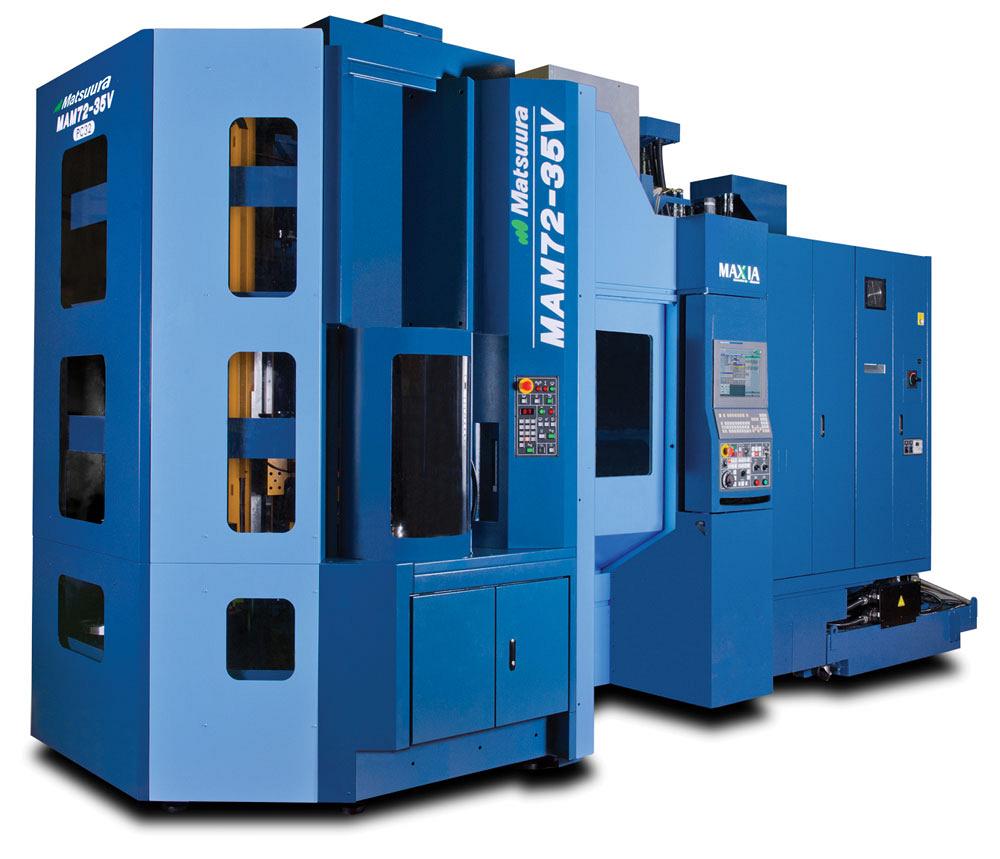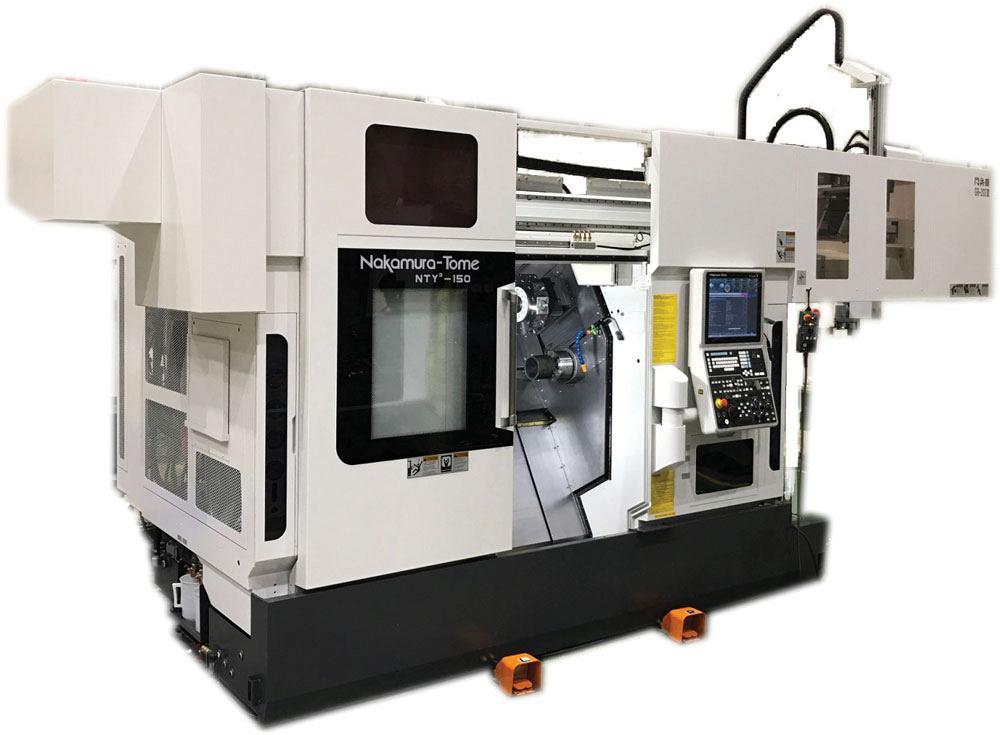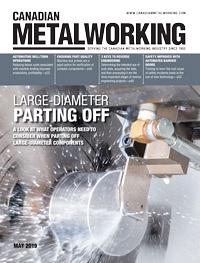Editor
- FMA
- The Fabricator
- FABTECH
- Canadian Metalworking
Automating mill/turn operations
Reducing labour costs associated with machine tending improves productivity, profitability
- By Joe Thompson
- June 17, 2019
- Article
- Metalworking

By automating changeovers, a machinist can have a high mix of parts, which means that automation is no longer just for high volumes. Photo courtesy of Okuma America Corp.
The simultaneous machining work of multitasking centres typically includes the turning and multisided milling of complex parts with tight tolerances. Secondary spindles and large-capacity ATCs give this type of machine tool the ability to completely finish a part in one setup.
The addition of automation enables this work to continue unattended, freeing up operators to work on several machines at once, rather than having them spend all of their time on load/unload tasks at a single machine.
Automation traditionally has been viewed as a requirement for high-volume production runs of one particular part. However, the manufacturing industry is changing, and the high-mix production common in multitasking now is becoming the norm.
Manufacturing technology has been forced to keep pace with these changes. But automation comes in many forms, and while complex robotic installations have their place, simpler options also are available.
“Automating a machine doesn’t necessarily mean putting a robot in front of it,” explained Kevin Smith, turning products manager for Elliott Matsuura Canada. “The word automation gets everybody excited, but they also can get scared about it. It doesn't necessarily have to be such a complicated process. Shops can get introduced to automation on the simplest scale, like a bar feeder or parts catcher, and go from there.”
Simple, in-situ automation includes conveyors and parts catchers integrated into a machine tool by the builder or distributor. It’s often beneficial for shops to understand that these common, well-understood accessories are, in fact, a type of automation and can lead to further, more complex automation being installed in the future.
“Once shops see the power of simple automation that’s already built into the machine, it’s easier for them to accept automation that is a little more complicated. Pretty soon they are asking about collaborative robots and completely automated workcells,” said Smith.
Load/unload
In multitasking equipment, a pallet system, in both vertical and horizontal configurations, is a popular method of automating a process. With this type of setup, a pallet can be loaded with raw material outside of the machine while parts are being created in the work zone. Then, when the pallets are swapped, finished parts can be unloaded and the process starts again.
“Every shop is concerned about the labour shortage,” said David Fischer, lathe product specialist at Okuma America Corp. “Automation gets a lot of attention because it naturally comes to mind when you think about eliminating labour from a machining process. Automation, when implemented correctly, can help shops wisely use their resources, including workers, even in high-mix part production.”
High-mix production
If a job requires unattended machining of a high mix of parts, the problem area always has been changeovers, which typically need to be done manually. But now technology exists that removes this roadblock by using a robot to change the chuck jaws.

The Matsuura MAM72-35V uses a vertical pallet system to increase spindle uptime that enables long periods of unattended operation. Photo courtesy of Elliott Matsuura Canada.
As part of a machining cell, this setup enables the operator to prepare the machine to run different parts in low volumes.
“As long as you have the pallet space and the raw material for these parts, it’s all automatic,” said Fischer. “Usually, if you’re going to run unattended, you need large lot sizes because the changeovers are manual and time-consuming. What we’ve done is automate the changeovers, so a machinist can have a high mix of parts, but still have the machine run unattended for a long period of time. This is significant because it means automation is not just for high-volume production anymore.”
This new type of automation practice is more flexible than in years past when dedicated systems were good for only one part. When that part was no longer being produced, automation systems – particularly robots – were mothballed, often never to be used again.
“The phrase today’s automation is a good one, because we are not talking about the same automation from even five years ago. It’s become simpler and more flexible, and it’s not cost-prohibitive anymore either,” said Smith. “In yesterday’s automation it also was necessary to bring in an automation specialist. What you essentially need now is somebody who knows how to use an iPhone®. It’s really that simple.”
If an operator is no longer standing in front of one machine for an entire shift, the machine is going to run continuously for the full shift (or two or more shifts) without being stopped to complete a new setup. Skilled workers no longer need to simply load the chuck and press cycle start. They can now leave the machine and go over to another machine.
“I don't believe that robots are going to eliminate the need for workers either,” said Smith. “They are going to eliminate the need for some of the unskilled work, and those workers can be upskilled and put on new tasks.”
Automation and tooling
One of these tasks that can be shifted to a now freed-up operator is tool assembly, a job that cannot be handed off to a robot.
“Mill/turn machines need more tools than stand-alone machine because they are engaging in multiple types of machining work. In an automated setup, the machine will run for a longer period, and therefore more tooling, especially redundant tooling, will be required,” said Fischer. “If you will be running long periods of unattended operation, a large-capacity toolchanger is required.”
It’s a good idea to load the ATC with the tools that are used the most and those that wear the fastest.
Editor Joe Thompson can be reached at jthompson@canadianmetalworking.com.

Gantry loaders a good automation system to keep multitasking machines productive. Photo courtesy of Elliott Matsuura Canada.
Elliott Matsuura Canada, www.elliottmachinery.com
Okuma America Corp., www.okuma.com
About the Author

Joe Thompson
416-1154 Warden Avenue
Toronto, M1R 0A1 Canada
905-315-8226
Joe Thompson has been covering the Canadian manufacturing sector for more than two decades. He is responsible for the day-to-day editorial direction of the magazine, providing a uniquely Canadian look at the world of metal manufacturing.
An award-winning writer and graduate of the Sheridan College journalism program, he has published articles worldwide in a variety of industries, including manufacturing, pharmaceutical, medical, infrastructure, and entertainment.
Related Companies
subscribe now


Keep up to date with the latest news, events, and technology for all things metal from our pair of monthly magazines written specifically for Canadian manufacturers!
Start Your Free Subscription- Trending Articles
Automating additive manufacturing

CTMA launches another round of Career-Ready program

Collet chuck provides accuracy in small diameter cutting

Sandvik Coromant hosts workforce development event empowering young women in manufacturing

GF Machining Solutions names managing director and head of market region North and Central Americas

- Industry Events
MME Winnipeg
- April 30, 2024
- Winnipeg, ON Canada
CTMA Economic Uncertainty: Helping You Navigate Windsor Seminar
- April 30, 2024
- Windsor, ON Canada
CTMA Economic Uncertainty: Helping You Navigate Kitchener Seminar
- May 2, 2024
- Kitchener, ON Canada
Automate 2024
- May 6 - 9, 2024
- Chicago, IL
ANCA Open House
- May 7 - 8, 2024
- Wixom, MI















